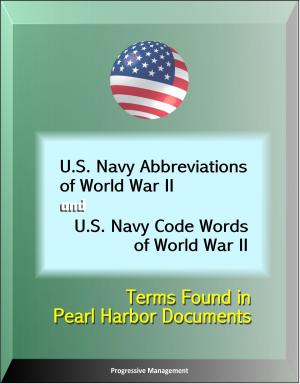Identifying and Defeating Infiltration Threats to the Homeland: German Sabotage in World War II, al-Qaeda, False Iraqi Freedom Lessons, China Threats, Attack Scenarios, Counterintelligence Shortfalls
Nonfiction, History, Military, World War II, Social & Cultural Studies, Political Science| Author: | Progressive Management | ISBN: | 9781310628153 |
| Publisher: | Progressive Management | Publication: | April 5, 2016 |
| Imprint: | Smashwords Edition | Language: | English |
| Author: | Progressive Management |
| ISBN: | 9781310628153 |
| Publisher: | Progressive Management |
| Publication: | April 5, 2016 |
| Imprint: | Smashwords Edition |
| Language: | English |
Professionally converted for accurate flowing-text e-book format reproduction, this unique book explores the full spectrum of infiltration threats to the Homeland and examines the danger posed by foreign controlled or directed operatives who enter the United States for the purpose of conducting espionage, sabotage, assassination or terrorist attacks. Using historical examples, it demonstrates the likelihood enemy operatives could enter the United States undetected and conduct hostile acts.
Following this discussion, the paper proposes an analytical framework useful for examining the full range of infiltration threats posed by both state and non-state actors. This framework includes an adversary's presence in the United States and the ease at which their nationals can access US society, their ability and demonstrated intent to conduct aggressive and sophisticated intelligence operations within the United States, the collection priorities of their espionage operations, the special operations capabilities of their military and paramilitary forces, and the nature of their military doctrine and their focus on asymmetric operations. The applicability of this analytical framework is demonstrated via an examination of Chinese infiltration capabilities. This examination explores the likelihood China would have the ability and intent to conduct terrorism, assassinations, sabotage attacks and espionage operations within the United States in the event of military conflict.
This paper also discusses the probable US targets enemy sabotage operatives would strike. It discusses four primary target categories including: 1) Strikes against critical military and civilian transportation infrastructure and assets required to deploy military forces; 2) Assaults against key military installations designed to destroy critical weapons systems and command and control nodes; 3) Assassinations of senior political and military leaders; and 4) Attacks designed to impact US morale.
INTRODUCTION * LESSONS FROM HISTORY * German Sabotage Threats During World Wars I and II * Al Qaeda Strikes America * False Lessons from Operation IRAQI FREEDOM * EXAMINING ENEMY INFILTRATION AND SABOTAGE THREATS * Infiltration Methods * A Framework for Analyzing Foreign Infiltration Threats * ANALYZING THE INFILTRATION AND SABOTAGE THREATS POSED BY THE PEOPLE'S REPUBLIC OF CHINA * China's Presence in the United States * PRC Intelligence Operations in the United States * Chinese Intelligence Collection Priorities * PRC Special Operations Capabilities * PRC Military Doctrine * Rating the Infiltration Threat Posed by China * ATTACK SCENARIOS * Attack Methods * Attacks on the Defense Transportation System * Attacks against Key Military Facilities and Leaders * Attacks Designed to Impact Morale * CI'S ROLE IN IDENTIFYING AND NEUTRALIZING INFILTRATION THREATS * Current US Counterintelligence Structure * DOD Counterintelligence Resource Shortfalls * DOD CI Structural Weaknesses * Current Laws and Directives that Impact DOD CI and Investigative Activities * Issues of Trust and Credibility * RECOMMENDATIONS AND CONCLUSIONS * Moving Beyond Terrorism to a Focus on Full-Spectrum Infiltration Threats * Meeting the CI Challenges of 21st Century * Improving the Connection Between DOD CI and the War Fighting Role of the COCOMs * Conclusion. * BIBLIOGRAPHY
Professionally converted for accurate flowing-text e-book format reproduction, this unique book explores the full spectrum of infiltration threats to the Homeland and examines the danger posed by foreign controlled or directed operatives who enter the United States for the purpose of conducting espionage, sabotage, assassination or terrorist attacks. Using historical examples, it demonstrates the likelihood enemy operatives could enter the United States undetected and conduct hostile acts.
Following this discussion, the paper proposes an analytical framework useful for examining the full range of infiltration threats posed by both state and non-state actors. This framework includes an adversary's presence in the United States and the ease at which their nationals can access US society, their ability and demonstrated intent to conduct aggressive and sophisticated intelligence operations within the United States, the collection priorities of their espionage operations, the special operations capabilities of their military and paramilitary forces, and the nature of their military doctrine and their focus on asymmetric operations. The applicability of this analytical framework is demonstrated via an examination of Chinese infiltration capabilities. This examination explores the likelihood China would have the ability and intent to conduct terrorism, assassinations, sabotage attacks and espionage operations within the United States in the event of military conflict.
This paper also discusses the probable US targets enemy sabotage operatives would strike. It discusses four primary target categories including: 1) Strikes against critical military and civilian transportation infrastructure and assets required to deploy military forces; 2) Assaults against key military installations designed to destroy critical weapons systems and command and control nodes; 3) Assassinations of senior political and military leaders; and 4) Attacks designed to impact US morale.
INTRODUCTION * LESSONS FROM HISTORY * German Sabotage Threats During World Wars I and II * Al Qaeda Strikes America * False Lessons from Operation IRAQI FREEDOM * EXAMINING ENEMY INFILTRATION AND SABOTAGE THREATS * Infiltration Methods * A Framework for Analyzing Foreign Infiltration Threats * ANALYZING THE INFILTRATION AND SABOTAGE THREATS POSED BY THE PEOPLE'S REPUBLIC OF CHINA * China's Presence in the United States * PRC Intelligence Operations in the United States * Chinese Intelligence Collection Priorities * PRC Special Operations Capabilities * PRC Military Doctrine * Rating the Infiltration Threat Posed by China * ATTACK SCENARIOS * Attack Methods * Attacks on the Defense Transportation System * Attacks against Key Military Facilities and Leaders * Attacks Designed to Impact Morale * CI'S ROLE IN IDENTIFYING AND NEUTRALIZING INFILTRATION THREATS * Current US Counterintelligence Structure * DOD Counterintelligence Resource Shortfalls * DOD CI Structural Weaknesses * Current Laws and Directives that Impact DOD CI and Investigative Activities * Issues of Trust and Credibility * RECOMMENDATIONS AND CONCLUSIONS * Moving Beyond Terrorism to a Focus on Full-Spectrum Infiltration Threats * Meeting the CI Challenges of 21st Century * Improving the Connection Between DOD CI and the War Fighting Role of the COCOMs * Conclusion. * BIBLIOGRAPHY















